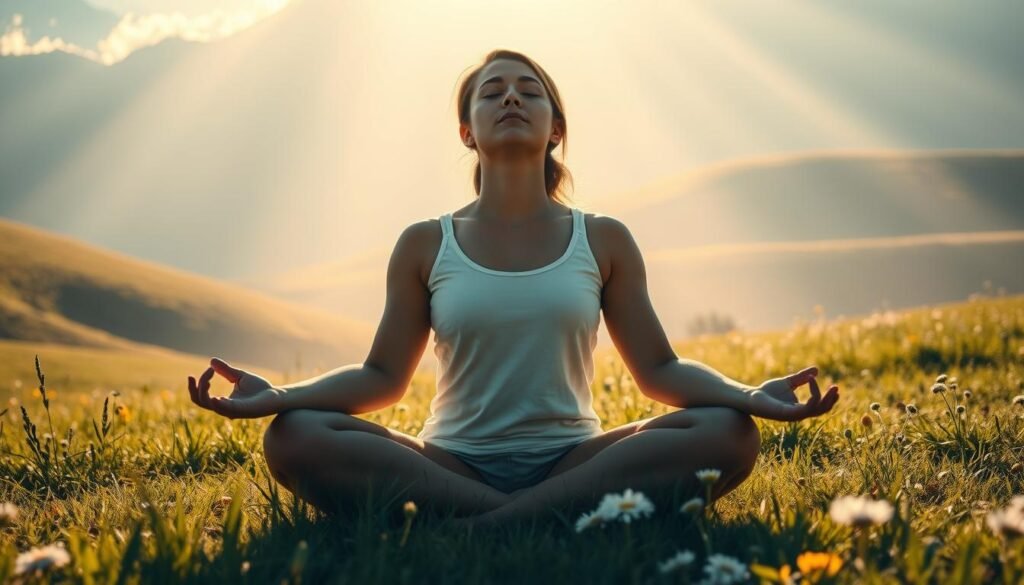Can a simple practice really calm the mind and soothe the soul? For many, the answer lies in cultivating a deeper sense of inner peace through mindfulness. In today’s fast-paced world, finding tranquility is more crucial than ever.
As we embark on this journey, we’ll explore the fundamentals of meditation and its numerous benefits. By understanding the basics, individuals can better navigate the path to achieving a more balanced and harmonious life.
Key Takeaways
- Discover the importance of cultivating inner peace in daily life.
- Learn the foundational principles of meditation.
- Understand how mindfulness can improve mental well-being.
- Explore practical tips for incorporating meditation into your routine.
- Find out how meditation can lead to a more balanced life.
Understanding Meditation Basics
To start your meditation journey, it’s key to know the basics. Meditation has been around for ages. It offers many ways to find mental clarity and peace within.
What is Meditation?
Meditation is a mindfulness practice. It trains your mind to focus, relax, and notice your thoughts, feelings, and body sensations. It’s about being aware of the present moment without judgment.
Meditation techniques vary, but they often include:
- Focusing on the breath or a mantra
- Noticing bodily sensations
- Cultivating loving-kindness towards oneself and others
Different Types of Meditation
There are many meditation practices, each with its own benefits and methods. Some popular ones are:
| Type of Meditation | Description | Benefits |
|---|---|---|
| Mindfulness Meditation | Focuses on being present in the moment | Reduces stress, improves focus |
| Loving-Kindness Meditation | Cultivates compassion and kindness | Enhances emotional well-being, fosters empathy |
| Transcendental Meditation | Uses a mantra to quiet the mind | Reduces anxiety, improves mental clarity |
Benefits of Practicing Meditation
Meditation offers many benefits, like stress relief and better mental clarity. It also boosts emotional well-being. Regular practice can lead to a more relaxed life and less anxiety.
Some key benefits include:
- Reduced stress and anxiety
- Improved focus and concentration
- Enhanced self-awareness
Mindfulness: The Heart of Meditation
Mindfulness is at the heart of meditation. It helps us connect deeply with the present moment. It’s not just a technique; it’s a way of life that brings awareness and clarity.
Defining Mindfulness
Mindfulness means being fully present and focused on the moment. We let go of distractions and judgments. It helps us understand ourselves and our experiences better.
Mindfulness exercises help us become more aware. They range from simple breathing to complex meditation practices.
How Mindfulness Relates to Meditation
Mindfulness and meditation go hand in hand. Meditation offers a structured space for mindfulness. It helps us find inner calm and clarity.
Regular meditation boosts mindfulness in our daily lives. It improves emotional control and reduces stress.
| Aspect | Mindfulness | Meditation |
|---|---|---|
| Focus | Present moment awareness | Structured practice for awareness |
| Goal | Cultivate awareness and clarity | Achieve inner calm and clarity |
| Practice | Informal and formal exercises | Formal sitting or guided practice |
Understanding the link between mindfulness and meditation helps us use both for better well-being.
Creating a Comfortable Meditation Space
A well-designed meditation space can greatly help you relax naturally. The setting where you meditate is key to a good practice.
To make the perfect meditation space, focus on a few important things. First, pick a quiet, comfy spot with no distractions.
Choosing the Right Location
Look for a spot with little noise and few people passing by. It should be quiet and secluded. This way, you can enhance focus and concentration better.
If you live in a busy place or have small space, think outside the box. Maybe turn a bedroom corner or use a peaceful outdoor area. The goal is to find a place that feels calm and relaxing.
Essential Items for Your Space
After picking the right spot, think about what you need to make it comfy. You might want a meditation cushion or chair, soft colors, and some plants.
A good cushion or chair is key for sitting right during meditation. You might also like candles, incense, or a white noise machine. These can make your space peaceful and help you relax naturally.
Don’t forget about the feel of your space. Soft lights, comfy temps, and no clutter can make it relaxing. This helps you enhance focus and concentration.
By choosing the right spot and adding the right items, you can make a space that supports your meditation. It will also help your overall well-being.
Setting Realistic Meditation Goals
Setting clear and achievable meditation goals is key to a successful practice. It helps build a consistent habit, leading to more mindfulness and peace. This section will help you define your goals and track your progress.
Defining Your Intentions
Understanding what you want from meditation is the first step. Do you want stress relief, better focus, or a deeper calm? Knowing your goals helps tailor your practice to your needs. Think about what motivates you and what you aim to achieve.
Tracking Your Progress
Tracking your progress keeps you motivated. Use a meditation journal or a mindfulness app to do this. Recording your practice shows patterns and areas for growth. Key things to track include:
- Duration of each meditation session
- How often you practice
- Any insights or feelings during or after meditation
By setting realistic goals and tracking your progress, you can improve your meditation. This makes it a rewarding part of your daily life. It also leads to a more balanced and fulfilling life.
Techniques for Relaxation and Focus
Relaxation techniques are key to lowering stress and boosting mental clarity. They help lead to a more balanced and fulfilling life.
Breathing Techniques
Breathing techniques are essential for relaxation and focus. Diaphragmatic breathing, or belly breathing, is a great method. It involves breathing deeply into the diaphragm, not shallowly into the chest.
- Start by sitting comfortably with your back straight.
- Place one hand on your belly and the other on your chest.
- Inhale deeply through your nose, allowing your belly to rise while your chest remains still.
- Exhale slowly through your mouth, letting your belly fall.
Regular practice of diaphragmatic breathing can reduce stress and anxiety. It promotes a sense of calm and relaxation.
Body Scan Method
The body scan method is a powerful relaxation technique. It involves focusing on different parts of your body, releasing tension as you go.
- Lie down or sit comfortably, closing your eyes.
- Begin at your toes, noticing any sensations or feelings.
- Gradually move your focus up through your body, releasing tension as you go.
This practice helps in identifying and releasing physical tension. It leads to deep relaxation.
| Technique | Primary Benefit | Secondary Benefit |
|---|---|---|
| Diaphragmatic Breathing | Reduces Stress | Improves Focus |
| Body Scan Method | Relaxes Muscles | Enhances Mindfulness |
Incorporating Meditation Into Your Daily Life
To really get the most out of meditation, you need to make it a part of your daily life. Doing so helps you stick to it more and boosts its benefits.
Finding Time in Your Schedule
Start by looking at your daily routine to find time for meditation. Try waking up a bit earlier or use your lunch break. Meditation apps can help you make the most of short sessions.
For beginners, it’s best to start small. Just a few minutes a day can make a big difference. As you get more comfortable, you can slowly increase the time you meditate.
Morning vs. Evening Practice
Morning meditation can make your day start off right, improving your focus and mental clarity. Evening meditation, on the other hand, can help you relax and get ready for sleep. Try both to see what fits your lifestyle best.
Here’s a quick guide to help you decide:
| Time of Day | Benefits | Considerations |
|---|---|---|
| Morning | Enhances mental clarity, sets a positive tone for the day | May require waking up earlier |
| Evening | Helps in unwinding, prepares for restful sleep | May interfere with evening activities if not scheduled properly |
By making meditation a regular part of your day, you’re taking a big step towards achieving inner calm and bettering your well-being.

Exploring Guided Meditation
Guided meditation is a great way to start improving your focus and concentration. It involves listening to a guide who leads you through steps or visualizations. This helps you reach a meditative state.
What is Guided Meditation?
Guided meditation has a teacher or guide to lead you. It’s perfect for beginners because it offers a clear path and keeps you focused. The guide might use things like visualization, breathing, or body scans to help you meditate.
Key Benefits of Guided Meditation:
- Reduces mind wandering
- Enhances focus and concentration
- Promotes relaxation and reduces stress
- Improves overall mental well-being
Best Apps and Resources for Beginners
If you’re new to guided meditation, there are many apps and resources to help you start. Here are some top picks:
| Resource | Description | Platform |
|---|---|---|
| Headspace | Offers personalized meditation sessions | iOS, Android |
| Calm | Features guided meditation and sleep stories | iOS, Android |
| Insight Timer | Provides a wide range of free guided meditations | iOS, Android, Web |
These tools are easy to use and meet different needs. They help beginners build a regular meditation practice.
Overcoming Common Obstacles
Starting a meditation habit takes effort and smart strategies to beat common problems. As you relax naturally and learn more about meditation basics, you’ll face challenges. These can test your dedication.
Dealing with Distracting Thoughts
Many meditators struggle with distracting thoughts. Our minds often wander, making it hard to find calm. Here are some tips to help:
- Acknowledge the thought and gently let it go, refocusing on your breath or chosen meditation object.
- Practice mindfulness by being present with your thoughts without judgment, allowing them to pass without attachment.
- Use a guided meditation to help keep your mind on track, especially when you’re starting out.

Maintaining Consistency
Keeping up with meditation can be tough, especially with a full schedule. Here are some ways to stay consistent:
- Set a regular time and place for your meditation practice, making it a habit.
- Start small, with short sessions that you can gradually increase as you become more comfortable with the practice.
- Track your progress, using a journal or app to monitor your consistency and reflect on your experiences.
By learning meditation basics and using these strategies, you can beat common hurdles. This way, you can enjoy the many benefits of regular meditation, learning to relax naturally along the way.
Understanding Inner Peace
Seeking inner peace is a common goal across cultures and ages. It’s a feeling of calm, contentment, and harmony within. Inner peace isn’t just the absence of conflict but a lasting sense of well-being.
The Concept of Inner Peace
Inner peace feels like being grounded and centered. It’s about accepting and loving oneself and others. Jon Kabat-Zinn, a mindfulness expert, said, “You can’t stop the waves, but you can learn to surf.” This shows the essence of inner peace – facing life’s challenges with grace and strength.
Techniques to Cultivate Inner Peace
To find inner peace, you need mindfulness, self-reflection, and emotional control. Here are some ways to help:
- Meditation: Regular meditation calms the mind and brings inner calm.
- Mindfulness: Mindful breathing or walking keeps you present and centered.
- Gratitude Practice: Thinking about what you’re thankful for shifts your focus to the positive.
- Self-Compassion: Treating yourself with kindness, like a close friend, builds inner peace.
By adding these practices to your life, your inner peace can grow. This journey needs patience, commitment, and self-awareness. Embracing it can lead to a more peaceful and fulfilling life.
“Peace is the only battle worth waging.” –
The Connection Between Meditation and Stress Relief
In today’s fast world, meditation is key for stress relief and clear thinking. More people are looking for ways to handle stress. So, it’s important to know how meditation helps.
Meditation has been around for ages. It comes from ancient cultures that saw its health benefits. It calms the mind and lowers stress in the body.
Reducing Stress through Meditation
Meditation lowers stress by starting the body’s relaxation response. This means lower blood pressure, heart rate, and stress hormones. Regular practice makes people more resilient to stress, boosting their health.
Key ways meditation fights stress include:
- Lowering stress hormones like cortisol
- Boosting mood with neurotransmitters like serotonin and dopamine
- Creating a calm state and reducing anxiety
Adding meditation to your day can help manage stress and clear your mind.
Real-Life Examples of Stress Relief through Meditation
Many studies and personal stories show meditation’s stress-fighting power. For example, mindfulness meditation helps with anxiety and depression in those with chronic stress.
| Stress Relief Technique | Description | Benefits |
|---|---|---|
| Mindfulness Meditation | Focusing on now to avoid past or future worries | Less anxiety, better mood |
| Transcendental Meditation | Using a mantra to quiet the mind and reach a deeper state | Lower blood pressure, less stress |
| Guided Meditation | Following audio to relax and imagine a calm state | Better sleep, less anxiety |
These examples show meditation’s power in fighting stress. It’s a simple, yet effective way to manage stress every day.
Long-Term Benefits of Meditation Practice
Starting a meditation habit can change your life for the better. It boosts both your mind and body. You’ll find it easier to focus and get things done.
Transforming Mental Health
Meditation helps your mental health a lot. It lowers anxiety and depression. By following simple meditation tips, you can feel calmer and more positive.
Enhancing Overall Well-being
Meditation does more than just help your mind. It also makes you feel better overall. It reduces stress, helps you sleep better, and makes you happier. As you keep meditating, you’ll become more balanced and peaceful.



